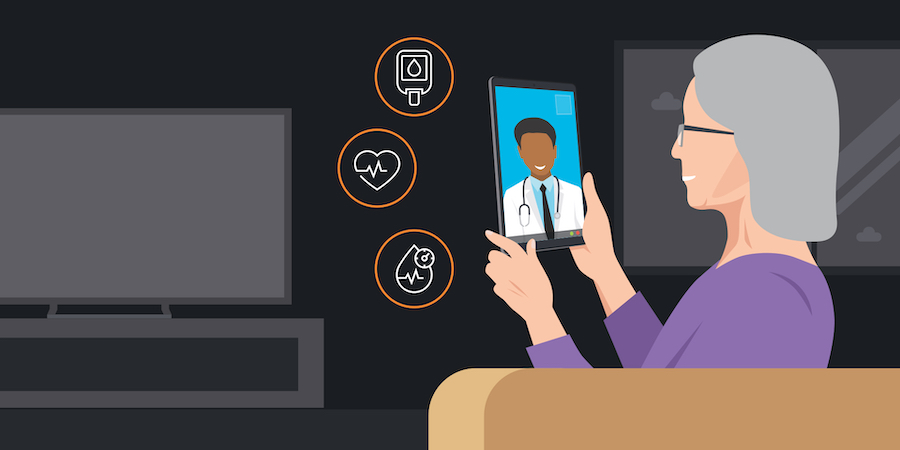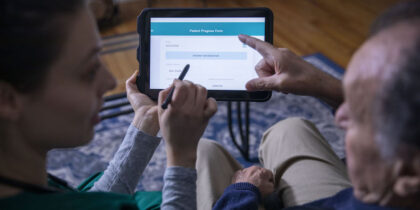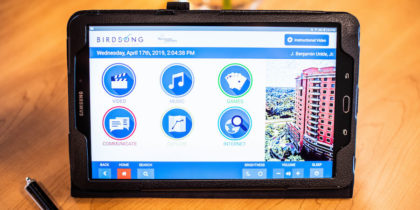Hospice care providers are accustomed to unpredictable and challenging work, but no one was prepared for COVID-19. Like most businesses, hospice organizations have struggled with significant logistical and financial challenges, especially early on in the pandemic. But the health crisis also provided opportunities for hospice and home healthcare to adopt new technology — and created new avenues for these businesses to grow.
Brandy Sparkman-Beierle, senior vice president of tech-enabled services at Homecare Homebase (HCHB), says the pandemic’s silver lining for hospice care is the newfound appreciation for flexible, patient-centric care delivery, including in-home hospice care and end-of-life services.
“Above all, this global pandemic has demonstrated the need for robust end-of life-care,” explains Sparkman-Beierle. “Ensuring appropriate staffing levels, providing emotional and physical support of clinicians, securing access to critical supplies, creating forward-thinking hospice/palliative care programs and technology and implementing policies that support caring for the sick at end of life are at the forefront more than ever before.”
As the leading electronic health record (EHR) solution for hospice and home care agencies, HCHB has been helping clients cope with the pandemic since it began — and, more importantly, helping them prepare for the post-COVID future.
The impact of COVID-19 on hospice
Hospice care faced sudden, unprecedented challenges due to COVID-19 — including facility lockdowns and personal protective equipment (PPE) shortages that limited care providers’ access to patients; a decrease in referrals; and inflexible reimbursement rules that prevent hospices and home health agencies from getting paid for virtual visits with Medicaid and Medicare patients. As a result, two-thirds of hospices expect a decrease in annual revenue in 2020, while 80 percent expect their operating costs to increase, according to the National Association for Home Care & Hospice’s (NAHC) Hospice COVID-19 Impact Survey.
HCHB responded quickly to help hospices manage COVID-related challenges and take advantage of new revenue-generating opportunities — namely, the rapid growth in remote patient monitoring (RPM).
“Our customers were rapidly acquiring telemedicine and remote monitoring technology, so we shifted our interoperability team to focus on new integrations,” says Scott Pattillo, chief strategy officer for HCHB. “We didn’t really have to make any material application changes to our software in support of COVID-19, because there are so many out-of-the-box capabilities in the platform that we were able to leverage very quickly. Within four weeks, we released dashboards that allow agencies to identify and locate COVID patients, along with CDC screening guidelines and COVID-19 care plans.”
An evolving solution for an evolving industry
More than 100,000 home health and hospice caregivers use the HCHB solution to care for their patients. A mobile app–based platform, HCHB has hundreds of customers representing thousands of industry branches that are caring for more than 700,000 patients a day, including hospice patients living at home or in long-term care facilities, as well as those being treated at inpatient hospice facilities. And almost all of that HCHB documentation is done on Samsung Galaxy tablets.
“One of the great things about HCHB and Samsung together is the ease of use of both the tablet and the software,” says Sparkman-Beierle. “It’s important to Homecare Homebase that we deliver exceptional care to our patients and an exceptional experience to the users in the field, and the Samsung tablets help us do that.”
Whether they’re treating inpatients or visiting people in their homes, hospice workers can use their tablets to access information, document care and communicate with their colleagues and patients. The solution delivers real-time data and tools that enable expert care around the clock, with a person-centered care plan that makes it easy for nurses, therapists, patients, families and other caregivers to have informed, real-time group meetings focused on the patient’s individual needs.
“Since 2005, we’ve deployed and refined our specialized hospice software,” says Sparkman-Beierle. “Today, eight of the country’s top 10 agencies use HCHB. By automating workflows for everything from scheduling to IDG [interdisciplinary groups], from billing to bereavement and volunteer management, we give caregivers the most important resource of all: more quality time with patients and families.”
It can also free up hospices’ resources so they can explore new lines of business — namely, palliative care — and even new business partners (e.g., home health agencies).
“Over the last few years, many home care providers looked into expanding into hospice services,” says Sparkman-Beierle. “During the pandemic, the need for palliative care has increased in awareness, raising the importance of end-of-life care within the care continuum. We expect to see additional growth in palliative service lines for hospice agencies.”
Build a better remote patient monitoring program
Discover solutions and best practices that transform patient experience and improve health outcomes. Download Now
As hospice and home care agencies continue to grow, evolve and often merge, HCHB continues to adapt its solution to agencies’ needs. Much of this innovation comes from strategic integrations and partnerships — such as with Muse Healthcare of St. Paul, Minnesota.
“Our exclusive product partnership with Muse gives HCHB customers a sophisticated predictive modeling interface to better forecast, prepare and provide for hospice patients,” explains Sparkman-Beierle. “This integration helps agencies enhance hospice care during the most critical time of a patient’s care journey — the last seven to 12 days of life. Our partnership helps providers allocate resources to the right patient at the right time, when they need it most. It addresses a well-documented gap in end-of-life care to help ensure every patient transitions [to hospice] with dignity, comfort and attention.”
Flexibility required for future hospice success
For hospice organizations and home health agencies, flexibility is a requirement and a competitive advantage. The need for more flexible, value-based care is driving demand for home health and hospice services, but Pattillo says agencies also need to be flexible in how they approach digital transformation.
“When you’re switching EHRs, the tendency is to say, ‘Here are all my processes, here are all my practices. I’m going to switch EHRs and just get better, because the technology is the problem,'” Pattillo explains. “But Homecare Homebase isn’t just software; it’s an operating model that shares best practices and drives consistency across your schedule, staffing and workflow management. HCHB helps you escalate work to make sure it gets done in a timely manner and ensure quality and compliant documentation in the home. You use the software to provide guidance and appropriate enforcement along the care continuum.”
Pattillo recommends new customers take the opportunity to critically examine their current processes and remain open to following Homecare Homebase’s best practices.
“Providers look at HCHB customers and say, ‘Wow, I want to be like them. I want the highest star ratings in the industry. I want the highest margins in the industry. I want the lowest cost per visits with the highest clinical outcomes in the industry,'” explains Pattillo. “But we’re not just selling software; we’re sharing best practices. Those best practices are just as valuable as the software, especially in the fast-paced, hyper-competitive era of COVID-19.”
“When you switch EHRs, it’s important to review your operating model and processes to look for areas of improvement,” Pattillo adds. “Make sure you are thinking not only about how to provide care but how you will grow and scale. What does the process look like for adding new branches or service lines? Are you set up to properly gather and report the data you need for compliance and payer requests for value-based care? How will you identify and address problems within your operation moving forward? We want to help our customers build a flexible framework that will continue to fit their needs as the industry changes.”
The pandemic has fueled digital transformation in hospice agencies that were lagging behind. It has also highlighted some of the barriers that have slowed innovation in the industry, and fast-tracked solutions to these problems — with new technology, new business models and, hopefully, upcoming federal legislation. In this challenging environment that’s rife with opportunity, flexible hospice organizations that use best-in-class technology will lead the way to the more inclusive future of end-of-life care.
As you enhance your home healthcare capabilites, you can learn more about how RPM works — including how it benefits healthcare providers and how you can get started — in this free, short guide. Or discover the full range of versatile healthcare solutions Samsung has designed for the age of telehealth.








